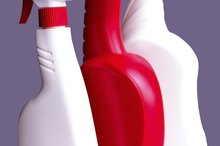What does fact checked mean?
At Healthfully, we strive to deliver objective content that is accurate and up-to-date. Our team periodically reviews articles in order to ensure content quality. The sources cited below consist of evidence from peer-reviewed journals, prominent medical organizations, academic associations, and government data.
The information contained on this site is for informational purposes only, and should not be used as a substitute for the advice of a professional health care provider. Please check with the appropriate physician regarding health questions and concerns. Although we strive to deliver accurate and up-to-date information, no guarantee to that effect is made.
How to Treat Clorox Fume Exposure
Clorox bleach, otherwise known as sodium hypochlorite, is a potentially dangerous household chemical that can cause serious injuries when it is swallowed or inhaled in large quantities 1. To avoid Clorox fume exposure, individuals should always use Clorox bleach in well-ventilated areas and wear a protective face mask--particularly if they are using full strength bleach or working with Clorox for an extended period of time.
Know the signs of Clorox fume exposure so that you can get immediate medical attention if you've inhaled too much of the toxic cleaning agent. Symptoms of fume exposure include coughing, mouth and throat pain, a gagging sensation, chest pain and lower heartbeat.
Skin Problems Following Chlorine Contact
Learn More
Go outside and breathe fresh air immediately after Clorox fume exposure.
Call the National Poison Control Center at 800-222-1222 and speak to an expert about your Clorox fume exposure. A representative will likely ask for details about the exposure and any symptoms you are currently experiencing so that they can either instruct you to go to the nearest hospital or give you instructions on how to treat the fume exposure yourself.
Side Effects of Sodium Carbonate
Learn More
Go to the hospital if the exposure was serious enough to warrant medical attention. In the emergency room, patients with fume exposure are often given oxygen or a breathing tube. The doctor may also order a bronchoscopy to look at the inside of the throat, esophagus and lungs.
Related Articles
References
Writer Bio
Lynn Burbeck is a professional writer with over five years of experience writing for the Web. She has published numerous articles for print and online media including "Grit" Magazine. Burbeck holds a B.A. in journalism and political science.







